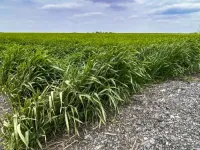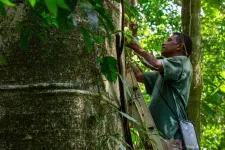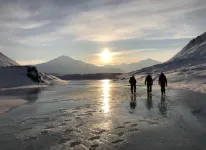(Press-News.org) URBANA, Ill. — Winter cover crops could cut nitrogen pollution in Illinois’ agricultural drainage water up to 30%, according to recent research from the University of Illinois Urbana-Champaign. But how will future climate change affect nitrogen loss, and will cover crops still be up to the job? A new study investigating near- and far-term climate change in Illinois suggests cover crops will still be beneficial, but not to the same degree. The report also forecasts corn and soybean yield across the state, finding corn will suffer much more than soybean, especially in southern regions.
In their earlier study, the research team adapted a crop simulation model known as Decision Support System for Agrotechnology Transfer (DSSAT) to estimate how efficiently cereal rye could remove nitrate from tile drainage water if planted widely across Illinois. In their new study, the team used DSSAT again to forecast growth of cereal rye, as well as corn and soybean, in the near-term (2021-2040) and far-term (2041-2060) under two climate scenarios for Illinois: a best-case-scenario and a business-as-usual case.
The team took a piecemeal approach, modeling each component of the system separately before combining them into a holistic prediction for the impact of cover crops under climate change.
To start, they modeled climate impacts on cash crop yield and cover crop biomass. Corn yield decreased in most Illinois regions, future timeframes, and climate scenarios, with average yield coming in 11.5% below to 3.8% above present averages. Soybean yield, however, mostly increased across regions and scenarios, with yields forecasted up to 27.5% higher than present averages. Finally, the model predicted cover crop biomass would boom as a result of climate change, with increases between 25% and 103% beyond current figures.
“Corn and soybean are two completely different kinds of crop, which is reflected in our results. The change in yield is due to multiple factors. Apart from the projected increase in temperature, the yield response is affected differently for each crop by changes in rainfall patterns and elevated CO2 levels in the future. We also found cover crops strongly benefit from warmer winter weather,” said study co-author Rabin Bhattarai, associate professor in the Department of Agricultural and Biological Engineering, a shared unit of the College of Agricultural, Consumer and Environmental Sciences (ACES) and The Grainger College of Engineering at Illinois.
Looking at nitrogen loss under climate change, the team predicted 24% greater loss in the near-term future, rising to about 42% by 2060.
“Warmer soil means microbes will be more active in converting nitrogen in organic matter to ammonium and then to nitrate in the soil. And if you have more nitrate in the soil, the potential for loss is higher,” Bhattarai said. “We already see high nutrient losses during warm, wet springs, even before crops are planted or fertilizer is applied. That nitrogen is escaping from the soil itself.”
With these baselines established, the researchers began making connections. First, they looked at the impact of cover crops on cash crop yield. In their previous DSSAT study, the researchers found growing cereal rye before corn and soybean had a slightly positive effect on yield. According to Bhattarai, cover crops slowly scavenge soil nitrogen throughout the winter and return the nutrient to the crop, providing a growth boost, when terminated and incorporated into the soil.
Under climate change, hungry swards of cover crops could deplete both soil water and nitrogen, even accounting for greater nitrogen availability predicted during warmer winters. Then, at termination, the sheer amount of cover crop biomass could overwhelm the mineralization apparatus of the soil, keeping some nitrogen locked up and unavailable for cash crops. However, although the yield benefit disappeared under future climate scenarios, the analysis did not reveal a yield penalty for growing cover crops.
“Whether you use cover crops or not, you're going to see a decline in corn yield in the future. The same applies to soybean. You may gain soybean yield whether or not cover crops are present,” Bhattarai said. “If you see any impact on the cash crop yield, it's not due to the cover crop, it's due to the changing climate.”
Finally, the team looked at cover crop impact on nitrogen loss under climate change. Relative to current conditions in which cover crops reduce tile drainage nitrogen by about 30%, cover crops are likely to become less effective under future scenarios, with as low as 11% reduction under far-term worst-case-scenario predictions.
“You don't get the same benefit that you get now. You will see better growth of cover crops with the warmer temperatures, but mineralization will overtake their ability to take up nitrogen; more supply than demand,” Bhattarai said. “Cover crops will help; they will still be effective at reducing loss. But the efficiency will drop.”
He added that farmers will have to augment cover crops with additional best management practices to meet nutrient loss reduction goals in the face of a changing climate.
The study, “Sustainability of cover cropping practice with changing climate in Illinois,” is published in the Journal of Environmental Management [DOI: 10.1016/j.jenvman.2023.117946]. Authors include Rishabh Gupta, Rabin Bhattarai, Hamze Dokoohaki, Shalamar Armstrong, Jonathan Coppess, and Prasanta Kalita. The research was supported by the Illinois Nutrient Research and Education Council (NREC) [project #017–3-360574–222]. Partial support was also provided by the USDA National Institute of Food and Agriculture.
END
Top corn producing state to see future drop in yield, cover crop efficiency
2023-07-06
ELSE PRESS RELEASES FROM THIS DATE:
New study: Black women with hypertensive disorders of pregnancy have increased stroke risk
2023-07-06
(Boston) – U.S. Black women have a disproportionately higher burden of both preeclamptic pregnancy and stroke compared with white women, but virtually all existing evidence on the association between the two medical conditions has come from studies of white women.
A newly published study focuses on data gathered over 25 years from 59,000 Black women in the Black Women’s Health Study (BWHS) and is led by researchers from Boston University Chobanian & Avedisian School of Medicine and Slone Epidemiology Center. The study, published in the New England Journal of Medicine Evidence, ...
Bezos Earth Fund grants $12 million to Smithsonian to support major forest carbon project
2023-07-06
By conserving and replanting forests, the world buys time until it brings other climate and sustainability solutions online. As a critical step toward this goal, the Smithsonian Tropical Research Institute (STRI) received a $12 million grant from the Bezos Earth Fund to support GEO-TREES. This international consortium is the first worldwide system to independently ensure the accuracy of satellite monitoring of forest biomass—a way to measure carbon stored in trees—in all forest types and conditions. The GEO-TREES alliance offers a freely accessible database that integrates ...
Legends of Norse Settlers drove Denmark towards Greenland
2023-07-06
In 985, Viking explorer Erik the Red led a group of Icelandic farmers to Greenland, where they established a settlement on the west coast. Archaeological evidence suggests that the settlement existed for over 400 years, but the impact of the settlement lasted much longer. It is little recognised today that the hope of finding the descendants of the settlers dominated European and American perspectives on Greenland for centuries
In his new book The Vanished Settlers of Greenland: In Search of a Legend and Its Legacy, Associate Professor Robert Rix argues that the lost Norse settlement played a decisive ...
Archaeology: The power of the Copper Age 'Ivory Lady' revealed
2023-07-06
The highest status individual in ancient Copper Age society in Iberia, was a woman and not a man as previously thought, according to peptide analysis reported in Scientific Reports. The individual, now re-dubbed the 'Ivory Lady', was buried in a tomb filled with the largest collection of rare and valuable items in the region, including ivory tusks, high-quality flint, ostrich eggshell, amber, and a rock crystal dagger. These findings reveal the high status women could hold in this ancient society.
In 2008, an individual was discovered in a tomb in Valencia, Spain dating to the Copper Age between 3,200 and 2,200 years ago. As well as being a rare example of a single occupancy ...
Schizophrenia is associated with somatic mutations occurring in utero
2023-07-06
As a psychiatric disorder with onset in adulthood, schizophrenia is thought to be triggered by some combination of environmental factors and genetics, although the exact cause is still not fully understood. In a study published in the journal Cell Genomics on July 6, researchers find a correlation between schizophrenia and somatic copy-number variants, a type of mutation that occurs early in development but after genetic material is inherited. This study is one of the first to rigorously describe the relationship between somatic—not inherited—genetic mutations and schizophrenia risk.
“We originally thought of genetics as the study of inheritance. But now we ...
Team develops all-species coronavirus test
2023-07-06
CHAMPAIGN, Ill. — In an advance that will help scientists track coronavirus variants in wild and domesticated animals, researchers report they can now detect exposure to the SARS-CoV-2 virus in any animal species. Most coronavirus antibody tests require specialized chemical reagents to detect host antibody responses against the virus in each species tested, impeding research across species.
The virus that causes COVID-19 in humans also infects a variety of animals, said University of Illinois Urbana-Champaign pathobiology professor and virologist Ying Fang, who led the new research. So far, ...
Shrinking Arctic glaciers are unearthing a new source of methane
2023-07-06
As the Arctic warms, shrinking glaciers are exposing bubbling groundwater springs which could provide an underestimated source of the potent greenhouse gas methane, finds new research published today in Nature Geoscience.
The study, led by researchers from the University of Cambridge and the University Centre in Svalbard, Norway, identified large stocks of methane gas leaking from groundwater springs unveiled by melting glaciers.
The research suggests that these methane emissions will likely increase as Arctic glaciers retreat and more ...
Health outcomes, cost-effectiveness of monoclonal SARS-CoV-2 antibodies as pre-exposure prophylaxis
2023-07-06
About The Study: This decision analytic model showed that within the context of a high SARS-CoV-2 probability, monoclonal antibodies pre-exposure prophylaxis (mAbs PrEP) provision was cost-saving when provided to individuals at increased risk of severe COVID-19 if drug prices decrease to $275 and effectiveness is 75% or higher. When newer mAbs PrEP combinations become available, guidance on implementation should be formulated ensuring a fast rollout. Nevertheless, advocacy for mAbs PrEP use and critical discussion on drug prices are necessary to ensuring cost-effectiveness for different epidemic settings.
Authors: Stephanie Popping, M.D., Ph.D., of the University ...
Hearing loss and fatigue in middle-age and older adults
2023-07-06
About The Study: Hearing loss was cross-sectionally associated with higher frequency of fatigue after adjustment for demographics, lifestyle factors, and comorbidities in this nationally representative sample of middle-age and older adults. Future studies with fatigue assessments capturing its multidimensionality are needed to understand how hearing loss might contribute to physical and mental fatigue differentially and clarify how hearing loss may be associated with downstream outcomes like physical impairment through fatigue.
Authors: Nicholas ...
Scientists develop strategy to engineer artificial allosteric sites in protein complexes
2023-07-06
According to a recently published research paper by a team of scientists, a groundbreaking approach has been developed to create artificial allosteric sites (where by binding an effector molecule, activity at the distal active site is regulated) in protein complexes. This breakthrough research holds significant promise for a wide range of applications in industrial, biological, medical, and agricultural fields.
The team’s work is published in Nature Chemistry on 06 July 2023 at 16:00 (London time)
Protein complexes, such as hemoglobin and molecular motors, ...








